
unstrung bows

strung bows
The two bows pictured below represent the typical Turkish design for target or infantry bows. One of the bows is 48" (122cm), the other 49" (124.5cm) along the curve between string nocks. Such lengths may surprise readers who read the popular books on Turkish archery by Klopsteg and Payne-Gallwey, where Turkish bows are shown as extremely short, up to 44" (112cm). However, the bows in the books are flight bows, a very specialized, sporting design, made to shoot very light arrows at extreme distances. Only some war bows, used on horseback, approach the flight bows in length, other bows, such as the target style, were longer for comfort and stability.
|
|
|
Bows of this shape can be seen in museums, for example the famous bows made for Sultan Bayezid II (early 16th c.) in Topkapi museum in Istanbul. Note the straight-through-grip limb shapes, fairly abrupt reflex at the beginning of shoulder (kasan) sections, the relatively straight kasan and another abrupt recurvature of the tip (bash). The ends of tips are shaped to resemble the more square, indented "Bayezid tip", unlike the better known, rounded "classical tip". The grips are relatively large and rigid. There are no string bridges which were never necessary in this style. The string is silk with silk loops.
I made the bows according to the usual methods. The cores are hard maple, the bellies horn and the backs covered with sinew. Since I was aiming for stability, the bows were not given the extreme reflex during sinewing, as it is done with flight bows. The tips do not have horn inserts or bone overlays, as the lighter draw weights did not require such reinforcements. The bows were covered with leather on the back side of arms and at the edges. Total physical weight was 330+ grams, less than, for example, the weight of Bayezid bows, but these bows have substantially lower draw weights than the old ones.
Both bows are about 64 lb at 28" draw. I measured the velocity of arrows with one of the bows: 205fps with 475 grain arrow and 182fps with 640 grain, a good performance for a regular longer bow.
All decoration is done in gold, period paints and lacquers, copied from 17th c. bows. Gilded ornaments on the back are known as "hatayi" (flower buds). The belly sides of kasans have framed inscriptions in Ottoman Turkish: the makerís name at one end and the date of manufacture at the other. The bellies have a couplet in taliq script which reads: "they call your eye a Tatar fit for battle, but God knows, you are an archer Turk with bow and arrows at itís side". On one of the arms there are two sentences by the last Turkish bowmaker and calligrapher Necmeddin Okyay (1883-1976): "skill is subject to praise, merchandise without clients is lost". A very fitting thought for a traditional bowyer!

Back of arm

Hatayi pattern on a different bow

Belly
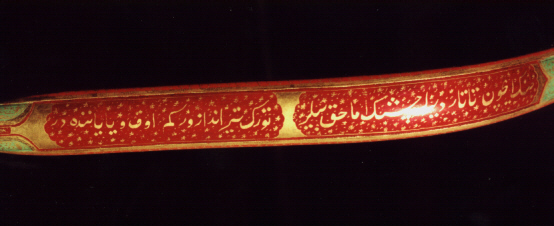
Belly
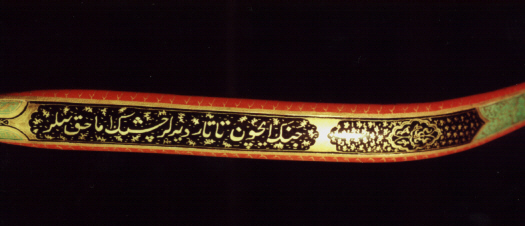
Belly
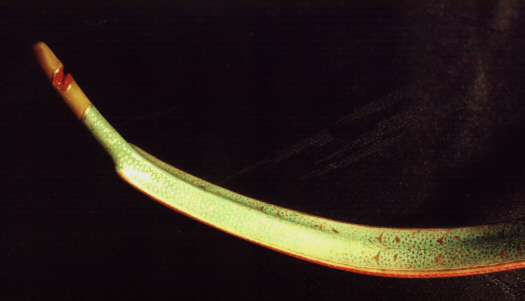
kasan and bash
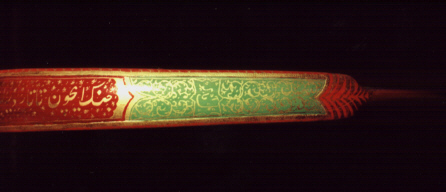
Belly of kasan
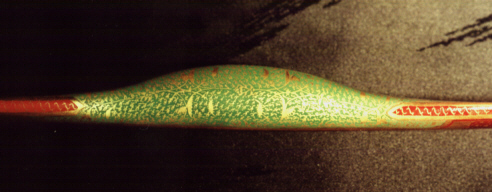 |
 |
Grip
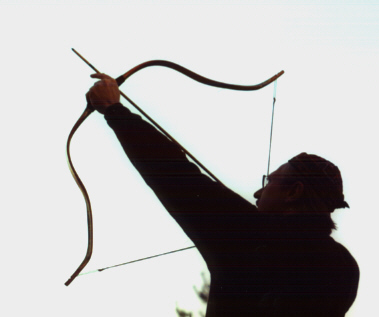
Drawn bow
Materials used for decoration:
Hide and bladder glues, sandarac resin, shellac, oil of linseed, rosin, oil of sandalwood, white lead, ochre, malachite, copper resinate, vermilion, madder, silver leaf, 23-karat gold.
In short, the bows are near-exact replicas of old Turkish bows, down to the last detail of decoration and materials, albeit without the patina of age.
Contact: akarpowicz@mta.ca